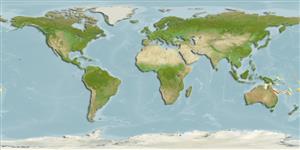>
Acropomatiformes (Oceanic basses) >
Banjosidae (Banjofishes)
Etymology: aculeatus: aculeatus, derived from
Name from Latin 'aculeatus' meaning spiny, referring to the strongly serrated spine at the angle of the preopercle in this species..
Issue
Species information for completion.
Environment: milieu / climate zone / depth range / distribution range
ນິເວດວິທະຍາ
ສັດທະເລ ອາໄສຢູ່ໃກ້ໜ້າດິນໃຕ້ພື້ນທ້ອງນ້ຳ; ລະດັບຄວາມເລິກ 60 - 294 m (Ref. 116322). Subtropical
Western Pacific: Australia, Coral Sea.
ຂະໜາດ / ນ້ຳໜັກ / Age
Maturity: Lm ? range ? - ? cm
Max length : 34.5 cm SL ຕົວຜູ້/ບໍ່ມີເພດ; (Ref. 116322)
Life cycle and mating behavior
Maturities | ການສືບພັນ | Spawnings | Egg(s) | Fecundities | ຕົວອ່ອນ
Matsunuma, M. and H. Motomura, 2017. Review of the genus Banjos (Perciformes: Banjosidae) with descriptions of two new species and a new subspecies. Ichthyol. Res. 64 (3): [1-30] 265-294. (Ref. 116322)
IUCN Red List Status (Ref. 130435)
Threat to humans
Harmless
Human uses
ເຄື່ອງມື
Special reports
Download XML
ແຫຼ່ງອີນເຕີເນັດ
Estimates based on models
Phylogenetic diversity index (Ref.
82804): PD
50 = 0.7500 [Uniqueness, from 0.5 = low to 2.0 = high].
Bayesian length-weight: a=0.01995 (0.00906 - 0.04395), b=3.01 (2.83 - 3.19), in cm total length, based on all LWR estimates for this body shape (Ref.
93245).
ຊັ້ນເຂດຮ້ອນ (Ref.
69278): 3.6 ±0.5 se; based on size and trophs of closest relatives
Fishing Vulnerability (Ref.
59153): Low to moderate vulnerability (32 of 100).
